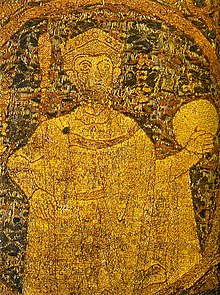
Back ستيفين الأول ملك المجر Arabic ستيفن الاولانى ملك المجر ARZ Esteban I d'Hungría AST Müqəddəs I İştvan Azerbaijani بیرینجی ایشتوان AZB Іштван I Святы Byelorussian Іштван I Сьвяты BE-X-OLD Стефан I Унгарски Bulgarian Stjepan I, kralj Ugarske BS Esteve I d'Hongria Catalan
| Saint Stephen I | |
|---|---|
 Portrayal of Stephen I on the Hungarian coronation pall (chasuble) from 1031 | |
| King of Hungary | |
| Reign | 1000 or 1001–1038 |
| Coronation | 25 December 1000 or 1 January 1001 |
| Successor | Peter |
| Grand Prince of the Hungarians | |
| Reign | 997–1000 or 1001 |
| Predecessor | Géza |
| Born | Vajk c. 975 Esztergom, Principality of Hungary |
| Died | 15 August 1038 (aged 62–63) Esztergom or Székesfehérvár, Kingdom of Hungary |
| Burial | |
| Spouse | Gisela of Bavaria (m. 996) |
| Issue | Otto Saint Emeric |
| Dynasty | Árpád |
| Father | Géza of Hungary |
| Mother | Sarolt |
| Religion | (pre-Great Schism of 1054) Catholicism |
| Signature |  |
Stephen I, also known as King Saint Stephen (Hungarian: Szent István király [ˌsɛnt ˈiʃtvaːn kiraːj]; Latin: Sanctus Stephanus; Slovak: Štefan I. or Štefan Veľký; c. 975 – 15 August 1038), was the last Grand Prince of the Hungarians between 997 and 1000 or 1001, and the first King of Hungary from 1000 or 1001, until his death in 1038. The year of his birth is uncertain, but many details of his life suggest that he was born in, or after, 975, in Esztergom. He was given the pagan name Vajk at birth, but the date of his baptism is unknown. He was the only son of Grand Prince Géza and his wife, Sarolt, who was descended from a prominent family of gyulas. Although both of his parents were baptized, Stephen was the first member of his family to become a devout Christian. He married Gisela of Bavaria, a scion of the imperial Ottonian dynasty.
After succeeding his father in 997, Stephen had to fight for the throne against his relative, Koppány, who was supported by large numbers of pagan warriors. He defeated Koppány with the assistance of foreign knights including Vecelin, Hont and Pázmány, and native lords. He was crowned on 25 December 1000 or 1 January 1001 with a crown sent by Pope Sylvester II. In a series of wars against semi-independent tribes and chieftains—including the Black Hungarians and his uncle, Gyula the Younger—he unified the Carpathian Basin. He protected the independence of his kingdom by forcing the invading troops of Conrad II, Holy Roman Emperor, to withdraw from Hungary in 1030.
Stephen established at least one archbishopric, six bishoprics and three Benedictine monasteries, leading the Church in Hungary to develop independently from the archbishops of the Holy Roman Empire. He encouraged the spread of Christianity by meting out severe punishments for ignoring Christian customs. His system of local administration was based on counties organized around fortresses and administered by royal officials. Hungary enjoyed a lasting period of peace during his reign, and became a preferred route for pilgrims and merchants traveling between Western Europe, the Holy Land and Constantinople.
He survived all of his children, dying on 15 August 1038 aged 62 or 63. He was buried in his new basilica, built in Székesfehérvár and dedicated to the Holy Virgin. His death was followed by civil wars which lasted for decades. He was canonized by Pope Gregory VII, together with his son, Emeric, and Bishop Gerard of Csanád, in 1083. Stephen is a popular saint in Hungary and neighboring territories. In Hungary, his feast day (celebrated on 20 August) is also a public holiday commemorating the foundation of the state, known as State Foundation Day.
© MMXXIII Rich X Search. We shall prevail. All rights reserved. Rich X Search